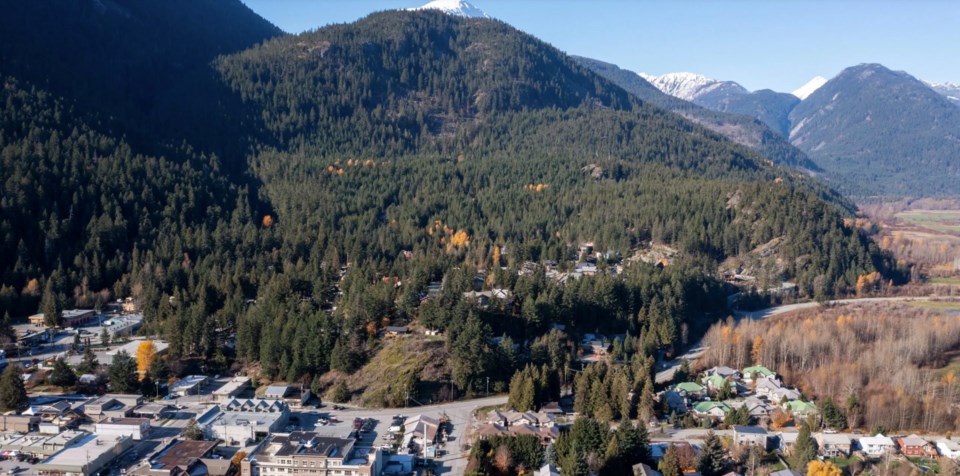As Pemberton considers its future through an extensive review of its Official Community Plan, some residents are asking questions about one of the biggest developments in the village’s history.
The proposed Nkwúkwma (Benchlands) development will see up to 450 residential units built over the next two decades on 31.2 hectares (77.1 acres) of land overlooking the village’s downtown core.
Led by Skénkenam Development LP, a partnership between the Lil’wat Nation’s Lil’wat Capital Assets and the Pemberton Benchlands Development Corporation, a proposed rezoning for the development will create a new neighbourhood that, at its full build-out, could house up to 1,350 people.
But in recent weeks, residents have raised concerns about a long list of issues regarding the proposed neighbourhood, including around access to Eagle Drive, off-site servicing improvements, increased demand for recreation, protection of existing trails and trail access, emergency access, stormwater runoff, wildlife corridors and affordable housing.
Hannah Den Duyf said she’s concerned about the potential domino effect of adding more traffic and people to the primary connection road in emergency situations.
“I currently live there, and while I don’t completely oppose [the development], I don’t necessarily think it’s been thought through properly,” Den Duyf said. “I live on Eagle Drive, which is apparently going to be the only road in and out of the development. I am uncomfortable thinking about how much traffic is going to be coming through the road, which is already extremely narrow, especially if there is some kind of emergency where everyone is leaving at once.”
Diane Rothdram echoed those concerns. As a Pemberton resident for the last 20 years, she has seen the village grow significantly, and is worried that the Village of Pemberton is not ready to handle hundreds of new residents from an infrastructure and staffing point of view.
Rothdram said she wants there to be more transparency around the rezoning process.
“My biggest concern is that the Village of Pemberton still kind of behaves as a small operation, but obviously we’ve got a lot of people, and you see that showing up when it comes to things like bylaw enforcement,” she said.
“It feels like there’s not enough transparency, and that the Village of Pemberton is working with developers a lot more than with the people who live here.”
Nkwúkwma’s land development manager, Caroline Lamont, is aware of residents’ concerns, and plans to incorporate their feedback as the proposal makes its way through the early stages of the rezoning application process.
“I know there’s a bit of opposition out there, but we’re still working through some of the finer details, which we’ll be working on in the next few months,” Lamont said. “We did a pop-up [information session] in the neighbourhood, and [residents] were definitely concerned with how the access road will work and how it will be improved and whether we can ensure safety for pedestrians in the area.”
One of the critical questions raised by Pemberton residents is whether or not the development will help address the village’s complex housing situation. Between 2016 and 2021, Pemberton’s population surged by 32.4 per cent, contributing to increased demand for services and rising housing prices.
The neighbourhood’s draft sub-area plan estimates that if the village continues to grow by a more modest 6.48 per cent over the next five years, the population will rise to 4,501 people and, within 15 years, up to 11,232 people.
Lamont said the development will provide a wide variety of housing that will help address the projected growth, and that the details of affordable housing options will be worked out with the municipality through the rezoning process, noting that affordable housing was a topic consistently brought up by residents at a public information held on April 20.
“There are definitely three lot sizes: a small lot, a mid and then large, which is more consistent with Eagle Drive, but there’s also townhomes and 40 apartment units,” Lamont said. “So there is a mix of housing, and then working with the village we’ll look at flex opportunities, whether that’s through accessory suites or lock-offs, or something like that, just to provide more opportunities for ground-access housing for a variety of people’s needs, [from] small families to singles to seniors.”
The original Benchlands Neighbourhood Concept Plan adopted in 2007 proposed a mixed-use neighbourhood consisting mostly of single-family homes, and Pemberton’s current OCP requires 25 per cent of new housing in the Benchlands to be multi-family housing.
The new sub-area plan represents a revised approach with a broader mix of residential uses, but a similar density of up to 450 dwellings.
But adding more density in Pemberton is something Mayor Mike Richman supports.
“I think there’s an absolute need [for increased density]. One of the ways we’re going to not necessarily solve but lessen the housing crunch and the affordability crisis is by making sure we provide all forms of housing within the housing continuum,” Richman said.
“If we just build single-family homes, the cost of single-family homes would continue to soar; we wouldn’t be supplying housing for many other demographics within our community. So I think, in general, we need to be very conscious and very thoughtful in building housing throughout the spectrum.”
Richman encourages residents to continue engaging in the rezoning process and to voice their concerns about the neighbourhood’s development as it makes its way through the rezoning process.
The Nkwúkwma development will be back before Pemberton’s mayor and council on May 23. Residents can learn more about the draft plan online at haveyoursay.pemberton.ca.




